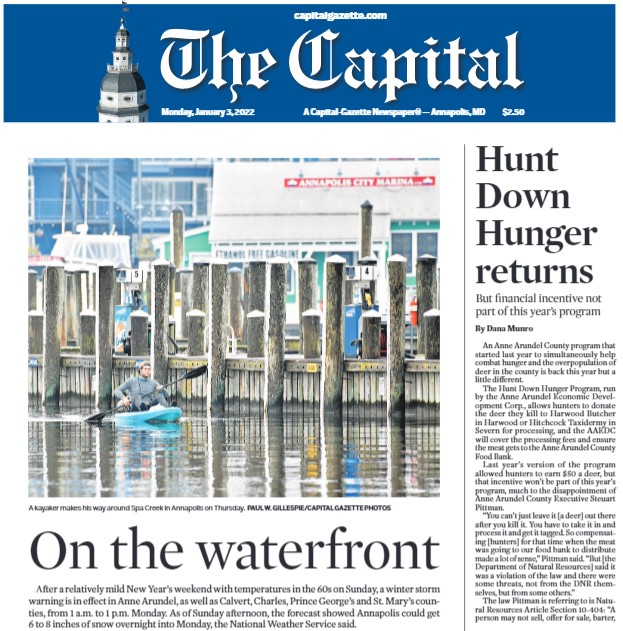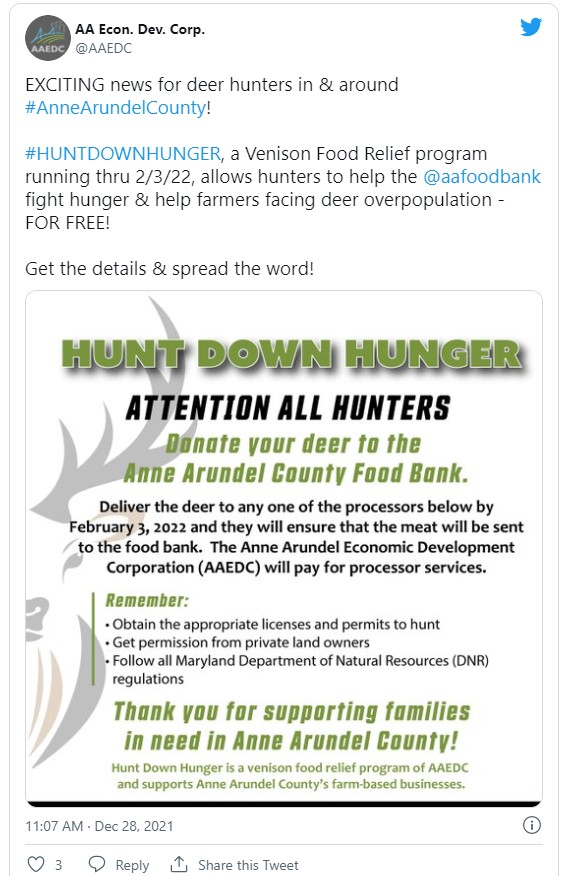Stay up to date on the county

Stay up to date on the county
Capital Gazette Puts AAEDC Venison Food Relief Program on Front Page
January 3, 2022
The Capital Gazette highlighted Hunt Down Hunger, a venison food relief program through which hunters in Anne Arundel County are encouraged to donate deer to the Anne Arundel County Food Bank, in the following article:
Published on the newspaper’s front page, the article covered the nuts and bolts of the program – AAEDC pays one of two processors in the county for processing the deer and ensures that the meat is delivered to the food bank – and its two-pronged mission: to provide high-quality protein to the growing number of food insecure in Anne Arundel County and help farmers who are facing the negative effects of deer overpopulation.
It included commentary from County Executive Steuart Pittman, who discussed the program in the context of current Department of Natural Resources policy restricting hunters from being directly compensated, as well as from Anne Arundel County Food Bank CEO Leah Paley and AAEDC President and CEO Ben Birge, both of whom expressed optimism regarding hunters’ participation.
Read the full article here:
An Anne Arundel County program that started last year to simultaneously help combat hunger and the overpopulation of deer in the county is back this year but a little different.
The Hunt Down Hunger Program, run by the Anne Arundel Economic Development Corp., allows hunters to donate the deer they kill to Harwood Butcher in Harwood or Hitchcock Taxidermy in Severn for processing, and the AAEDC will cover the processing fees and ensure the meat gets to the Anne Arundel County Food Bank.
Last year’s version of the program allowed hunters to earn $50 a deer, but that incentive won’t be part of this year’s program, much to the disappointment of Anne Arundel County Executive Steuart Pittman.
“You can’t just leave it [a deer] out there after you kill it. You have to take it in and process it and get it tagged. So compensating [hunters] for that time when the meat was going to our food bank to distribute made a lot of sense,” Pittman said. “But [the Department of Natural Resources] said it was a violation of the law and there were some threats, not from the DNR themselves, but from some others.”
The law Pittman is referring to is Natural Resources Article Section 10-404: “A person may not sell, offer for sale, barter, or exchange, at any time within the State any game bird or game mammal taken from the wild.” Some have argued last year’s program violated the state law, which essentially bans local governments from offering bounties on the heads of wild animals.
Pittman’s administration brought legislation to the Maryland General Assembly last session to legalize this financial incentive, but it didn’t end up getting voted on.
However, the administration was still determined to bring the program back in 2022 in whatever form they could.
“We decided to just go ahead with covering the costs of the processing, which we did before as well. We hope some hunters will take advantage of that,” Pittman said.
But Pittman, a longtime farmer himself, said it’s been a frustration of his for a while that the DNR has failed to address the increasing herd of deer which eats the crops farmers labor over all year long, eats the undergrowth in county forests, causes vehicular collisions and expedites the spread of diseases such as Lyme disease by bringing ticks into farms.
“The DNR has not implemented programs they know will reduce the size of the herd, and that’s been very frustrating,” he said. “So the farmers are feeding the deer, and it’s coming out of their pockets.”
Since the DNR is partially funded by hunting licenses, it is incentivized to keep the herd large enough to get lots of people hunting, Pittman said.
“They’re funded by the hunting community, and they have a committee of hunters who advise them. I think, unfortunately, it’s the leadership of some of those hunting organizations that I think is not with the times. They don’t recognize just how many deer there are,” he said.
Regardless, Pittman hopes there will be an opportunity to reintroduce the bill at the upcoming General Assembly legislative session, which he said would benefit the whole state as overpopulation of deer is a statewide issue.
“It depends on whether we can get enough interest from legislators,” Pittman said. “But we’re certainly talking to them about it. It’s good public policy.”
This year’s Hunt Down Hunger Program already had a lot to live up to. Last year’s program brought in 225 deer, which became 5,727 pounds of venison meat for the Anne Arundel County Food Bank.
“Our partners continue to experience a high demand for food assistance,” Anne Arundel County Food Bank CEO Leah Paley wrote in an email. “They served 90% more Anne Arundel County residents between July and October 2021 versus two years ago (pre-pandemic) during the same period of time.”
Paley said the program allows the food bank to meet the increasing need and offer its more than 70 partner pantries diversity in the protein sources they can provide residents.
Even without the incentive, this year’s program will almost certainly be smaller as it will only take place in the county this year. Last year’s program was available to the whole state of Maryland. The modification is due to changes in the funding source and the county’s desire to make the program more targeted.
“Last year when we had the CARES funding from the federal government it had some restrictions on it and deadlines on it, so it made more sense to open it up,” said Ben Birge, president and CEO of the Anne Arundel Economic Development Corp. “Now we have so much more flexibility under the ARP [American Rescue Plan] funding.”
The county requested $126,000 for the program in 2021; with the smaller scale and the expertise the AAEDC gained from running last year’s program, it only asked for $16,000 this year. Last year’s program ended up having a lot of money leftover that all got donated to the food bank, Birge said.
“I’m looking forward to seeing what the numbers look like this year,” he said. “Hopefully it’ll be hugely successful.”
Hunters must have the necessary licenses and permits and must get permission from private land owners and follow DNR hunting rules. The program runs through Feb. 3.
Press Contact
For all media inquiries, please contact:
Victoria Zelefsky
P 410-222-7410
E [email protected]
